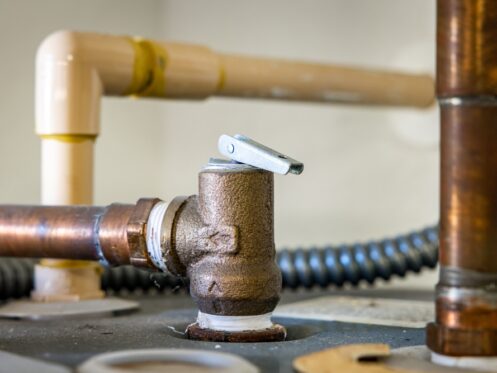Water heaters add to your Denver area household’s comfort and convenience, allowing you to perform daily tasks like washing dishes, taking showers, doing laundry, and more with hot water available at the turn of a knob or the push of a button.
Standard water heaters — and some tankless models — have a water heater pressure relief valve to discharge excess steam and hot water. Knowing where the pressure relief valve is on the hot water heater is important because you can test it yourself or check whether it’s leaking or corroded.
At High 5 Plumbing, our professional plumbers are experienced in water heater repair, maintenance, and replacement. If you suspect a problem with your pressure relief valve, schedule service immediately to avoid potential injury or damage to your home.
Function of the Pressure-Relief Valve
The pressure relief valve is a safety mechanism that allows excess pressure and hot water to escape. Water heaters produce heat, which makes the water expand as it transforms into steam. Temperatures reach upwards of 200°F and cause extremely high pressure, usually up to 150 PSI. Letting pressure build inside a completely closed container like a water tank may eventually cause the tank to rupture or explode.
Once the heat or the pressure reaches safety limits, the pressure-relief valve opens automatically, releasing hot water and steam safely through a discharge pipe and into a drain located a few inches away. This lowers the interior pressure and temperature of the tank back to safe levels.
Safety Considerations
A ruptured water tank is inconvenient, but there are safety considerations to keep in mind as well. The water tank might explode, flooding your home with scalding hot water and potentially launching metal parts of the tank through the house, causing injury.
The pressure relief valve is usually located on the top or side of your tank, with a pipe called a “discharge tube” extending away from the tank. To check whether the valve is working correctly, open the valve handle slowly and carefully to avoid being splashed by hot water.
If you’re experiencing problems with your pressure relief valve, or if you’re not comfortable testing it on your own, call High 5 and schedule service with one of our licensed plumbers. We’ll check over your water heater and give you our recommendations for repairs or a full replacement. We’ll put your mind at ease and give you all the information you need to make an informed decision.
Common Valve Issues and Troubleshooting
Some common issues that occur with pressure relief valves on residential water heaters include the following.
Rusting or corrosion
Water heater pressure valves are made from stainless steel, brass, plastic, and/or aluminum. In some cases, minerals in the water cause corrosion. Oxygen may lead to rusting, which stops the valve from smoothly opening and closing. Over time, its ability to regulate the pressure and temperature inside the tank is impeded.
Mineral deposits
Areas with hard water need more frequent water heater maintenance due to the sediment and mineral deposits that form inside the tank. The Colorado area has soft to moderately hard water, but the mineral content varies due to snowmelt from the Rockies. Mineral deposits inside the valve make it more difficult for the valve to open and close, leading to malfunction.
Pressure surge damage
A sudden wave of high-pressure steam or hot water flowing through the valve can cause serious damage to the structure of the valve. It might become stuck or too weak to fully close, causing flooding.
Try these tips to check for problems with your water heater pressure relief valve:
- Look for consistent leaks or water pooling around the tank.
- Listen for strange sounds like hissing, rattling, or whistling.
- Open the valve once a year to make sure the water releases when it should.
- Check for visible sediment buildup, damage, or corrosion on the valve.
- Monitor your home’s water pressure — valve issues contribute to inconsistent home water pressure.
Maintenance Tips
Regularly maintaining your water heater and pressure relief valve helps it continue to work correctly, keeping your household safe from damaging leaks or hazardous bursts.
Schedule regular water heater maintenance
Having the tank flushed regularly by an experienced plumber helps prevent sediment from causing serious blockages. A maintenance appointment also gives the plumber an opportunity to test the valve and ensure it works correctly.
Test the valve function
Issues with the valve, including sticking or low flow when testing, indicate that it needs to be replaced right away.
Check manufacturer recommendations
Your water heater manufacturer has likely given a recommendation for when to replace your pressure relief valve. In most cases, it needs to be replaced every few years, although each water heater model is unique.
Need Help With a Water Heater Pressure Relief Valve? Contact the Team of Plumbers at High 5
High 5 provides affordable, high-quality plumbing services to our customers in communities throughout Colorado, including Denver, Golden, Littleton, Castle Rock, Eastlake, Wheat Ridge, Louisville, and Lafayette.
We focus on what’s needed and the most effective way to do the job. We’re upfront with our pricing and do all we can to earn our customers’ trust and satisfaction. Contact us today to learn more about us or to schedule a plumbing service.

